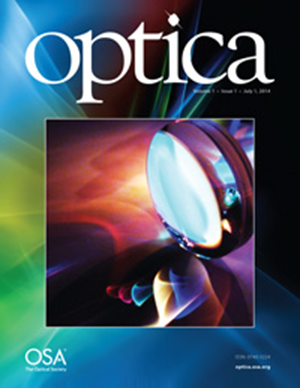用于空间模式分类和解复用的轨道-角动量相关斑点
IF 8.5
1区 物理与天体物理
Q1 OPTICS
引用次数: 0
摘要
轨道角动量(OAM)模式的表征对于 OAM 编码的数据传输至关重要。然而,传统的表征方法要么依赖于复杂而精确的实验配置,要么依赖于复杂的先验信息处理。在这些情况下,散射效应产生的依赖于 OAM 的斑点的相关特性很少受到关注。在这里,我们研究了散射介质产生的 OAM 斑点的交叉相关特性,并提出了一种基于 OAM 依赖斑点的空间模式分类和解复用的有吸引力的替代方法。我们通过理论和实验证明,两个不同的 OAM 依赖斑点之间的交叉相关操作可以均匀地衍生出一个环形图案,其尺寸由两个相应 OAM 模式之间的绝对拓扑电荷差值决定。基于这一机制,通过在非相干测量的 OAM 依赖斑点之间实施交叉相关操作,可以轻松地对原始相干 OAM 模式进行分类。为了充分利用 OAM 依赖性斑点的正交特性,我们还利用地面玻璃扩散器构建了 OAM 模式解复用实验,成功演示了 8 位灰度和 24 位 RGB OAM 编码数据的解复用,误差率极佳。结果表明,以往在实际应用中被视为干扰因素的 OAM 相关斑点,竟然可以作为 OAM 模式分类和解复用的竞争候选对象,从而为光通信和信息处理开辟了新的方向。本文章由计算机程序翻译,如有差异,请以英文原文为准。
Orbital-angular-momentum-dependent speckles for spatial mode sorting and demultiplexing
Characterizing the orbital-angular-momentum (OAM) modes is critically important for OAM-encoded data transfer. However, traditional characterizing approaches rely on either complex and precise experimental configurations or complicated prior information processing. In these scenarios, the correlation features of OAM-dependent speckles from the scattering effect have received little attention. Here, we investigate the cross-correlation characteristics of the OAM speckles resulting from a scattering medium and propose an appealing alternative for spatial mode sorting and demultiplexing based on the OAM-dependent speckles. We demonstrate theoretically and experimentally that the cross-correlation operation between two different OAM-dependent speckles can uniformly derive an annulus pattern, whose dimension is determined by the absolute topological charge difference value between the two corresponding OAM modes. Based on this mechanism, the original coherent OAM modes can be easily sorted by implementing the cross-correlation operation between incoherently measured OAM-dependent speckles. To fully capitalize on the orthogonal feature of the OAM-dependent speckles, we also construct OAM mode demultiplexing experiments using a ground glass diffuser, where both 8-bit grayscale and 24-bit RGB OAM-encoded data demultiplexing are successfully demonstrated with superior error rates. Results show that the OAM-dependent speckles, previously treated as a nuisance for practical applications, can be surprisingly utilized as a competitive candidate for OAM mode sorting and demultiplexing, thus opening new directions in optical communication and information processing.
求助全文
通过发布文献求助,成功后即可免费获取论文全文。
去求助
来源期刊

Optica
OPTICS-
CiteScore
19.70
自引率
2.90%
发文量
191
审稿时长
2 months
期刊介绍:
Optica is an open access, online-only journal published monthly by Optica Publishing Group. It is dedicated to the rapid dissemination of high-impact peer-reviewed research in the field of optics and photonics. The journal provides a forum for theoretical or experimental, fundamental or applied research to be swiftly accessed by the international community. Optica is abstracted and indexed in Chemical Abstracts Service, Current Contents/Physical, Chemical & Earth Sciences, and Science Citation Index Expanded.
 求助内容:
求助内容: 应助结果提醒方式:
应助结果提醒方式:


